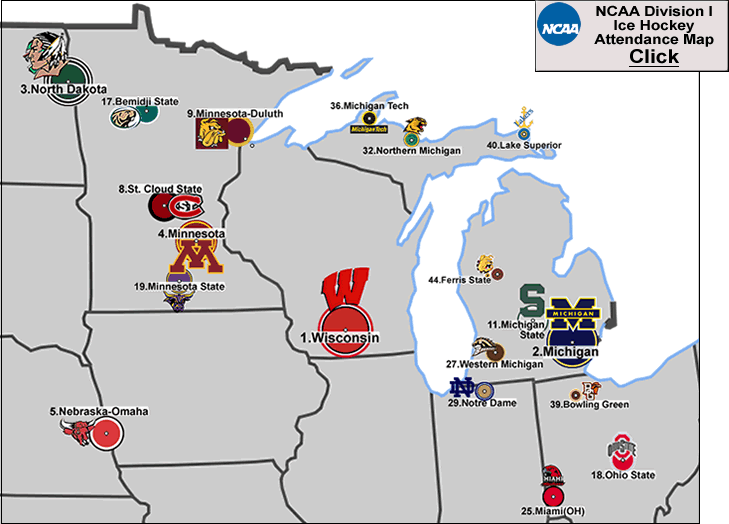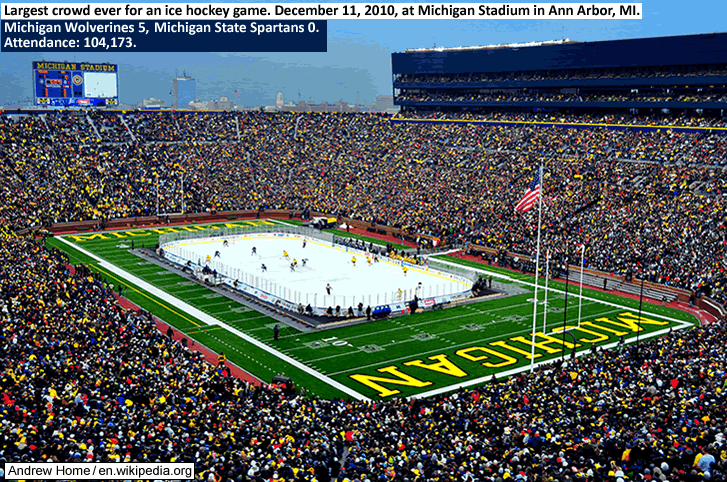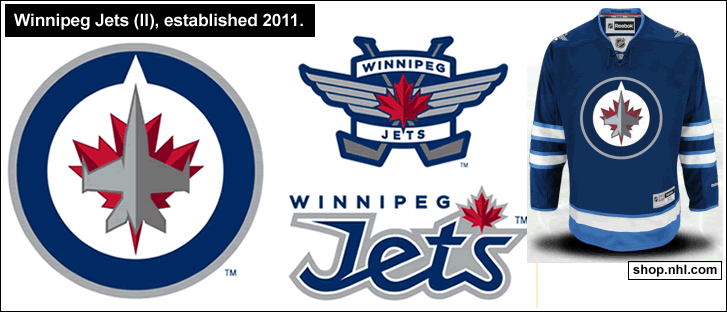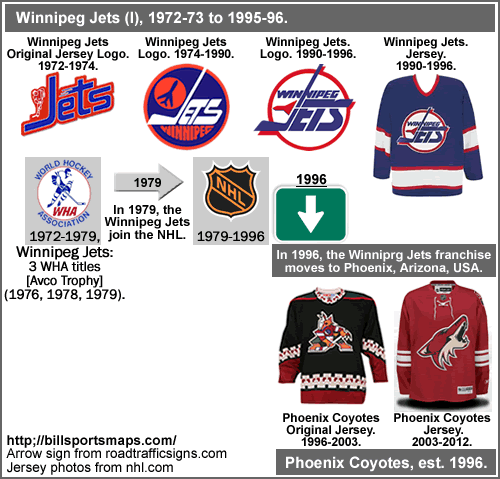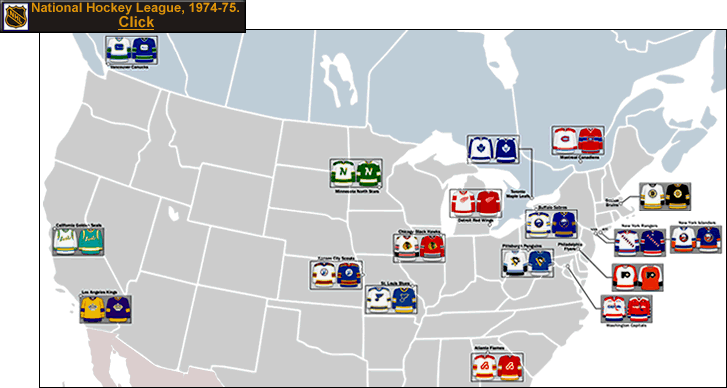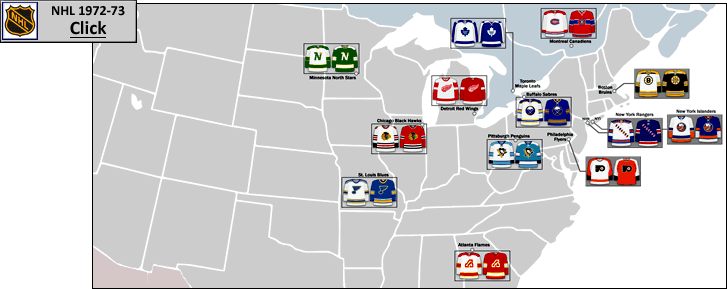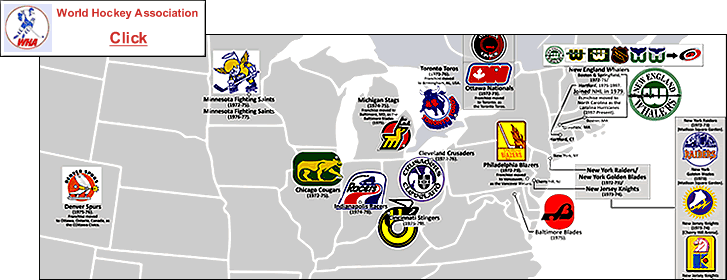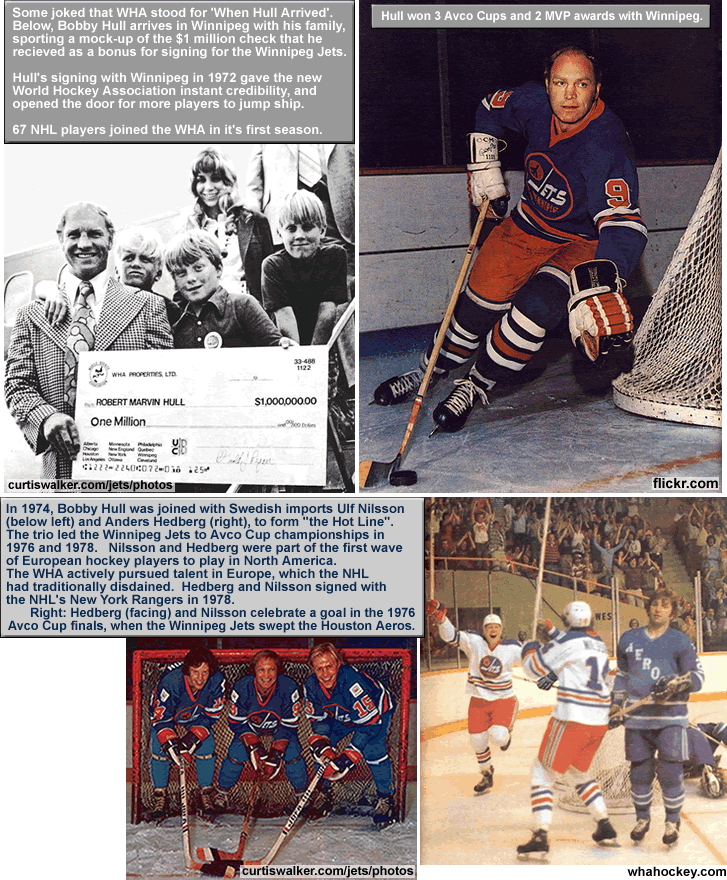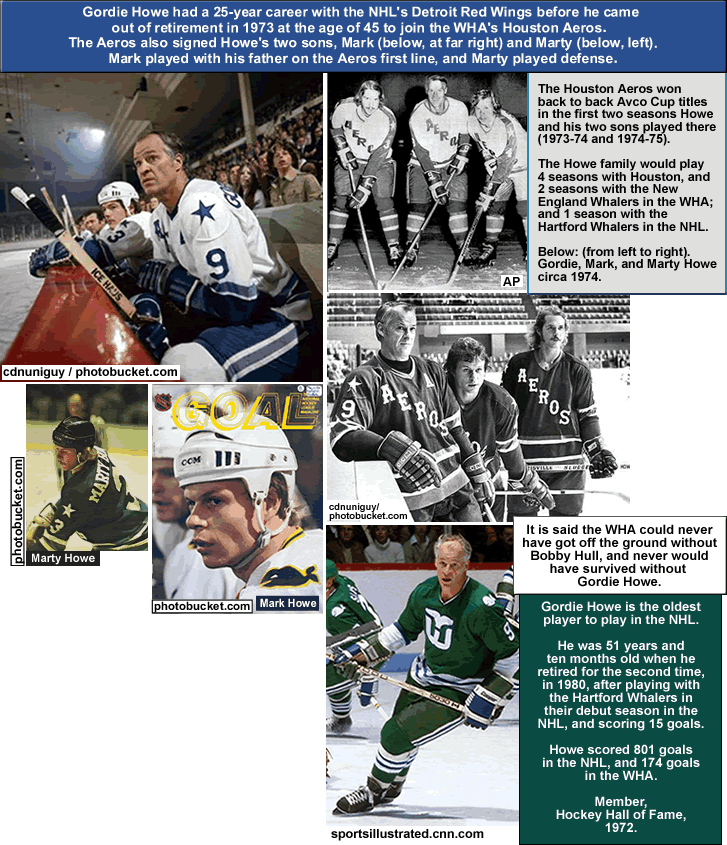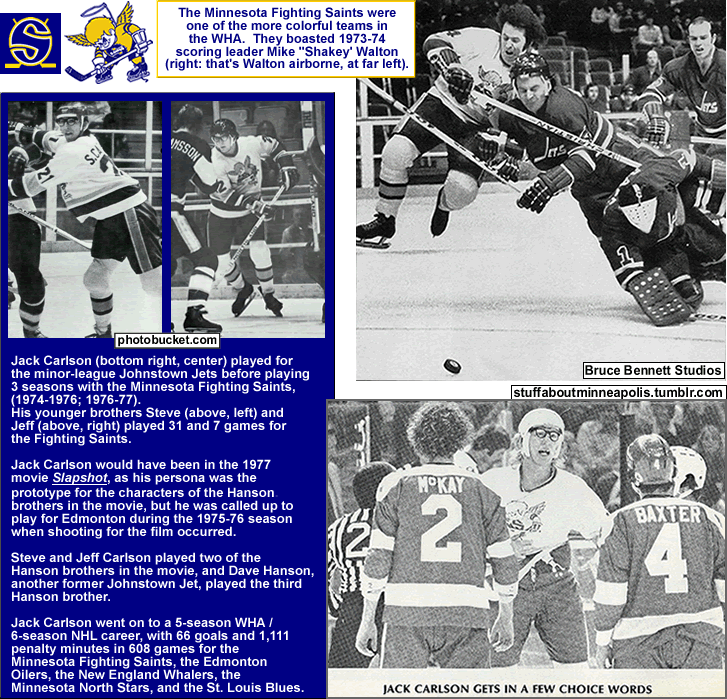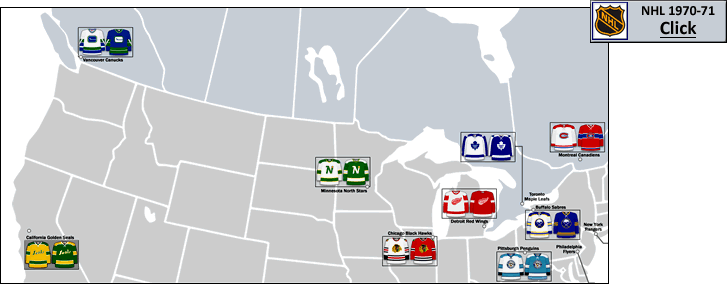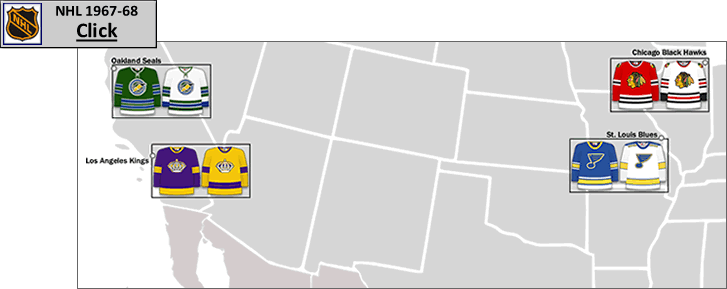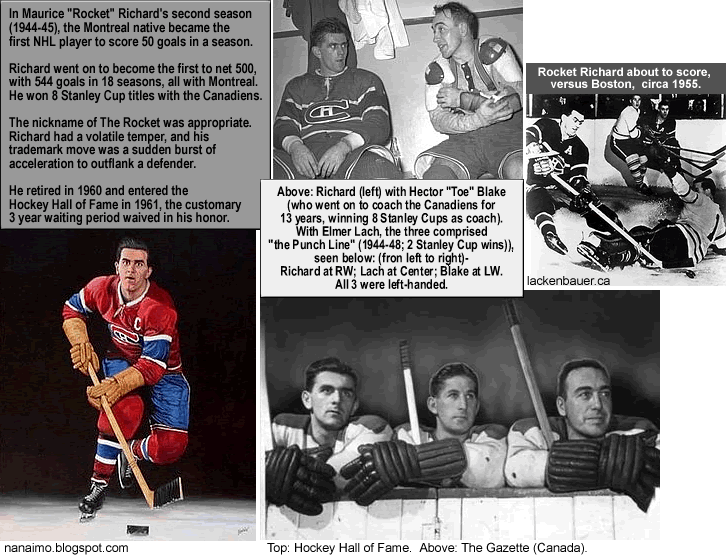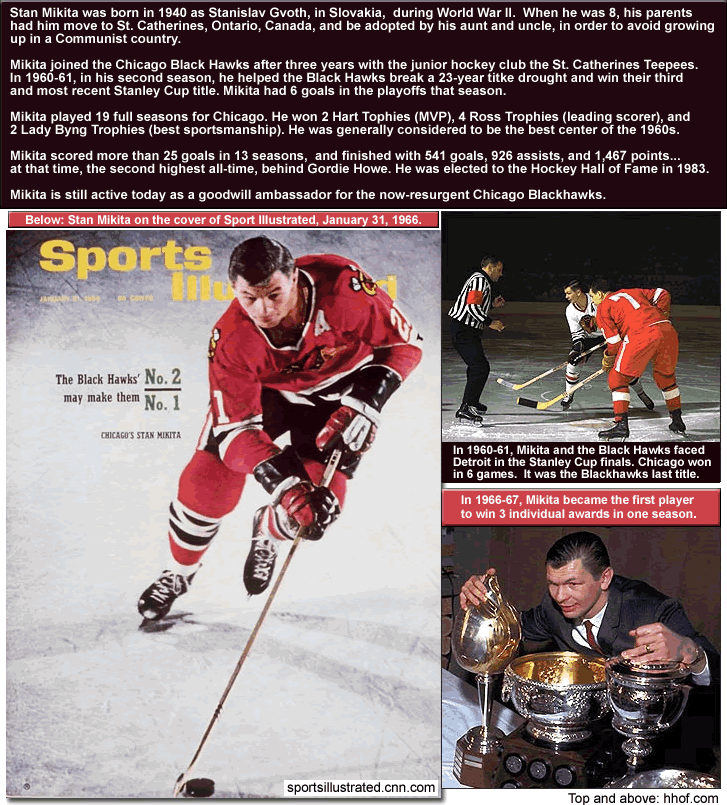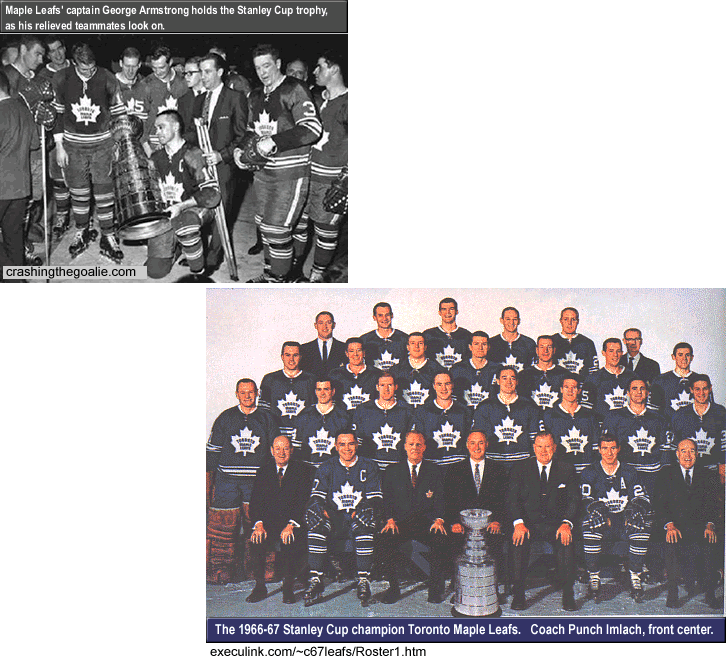
1979-80 NHL
…
…
Note about the map page…teams are listed not by divisions, but alphabetically – with 1979-80 NHL teams starting with the letters A through M on the left side of the map page; and 1979-80 NHL teams starting with the letters N through W on the right side of the map page. The explanation for this is in the following paragraph.
[In all the other installments of this series (Hockey - NHL and Expansion]) I have grouped the teams on the map page by divisions and conferences. But for this map, I have listed the NHL teams by alphabetical order, going from ‘A’ at the top left, to ‘W’ at the bottom right. I did this because the league format that the NHL created in 1979-80 rendered the divisional set-up meaningless. For two seasons, 1979-80 and 1980-81, the 21-team NHL had a balanced schedule with all teams playing other teams 4 times (80-game regular season), and, crucial to my point here, all the playoff teams (16 playoff teams) were seeded. In other words, for two seasons, the NHL’s divisions were pointless, because the only way that divisional status had an impact was this: the divisional winners automatically qualified for the playoffs (as did the 12 next-best teams as wild-cards). But since over three-quarters (76%) of the teams qualified for the playoffs back then (talk about watering down your product), the divisions meant nothing. That is because the only way this “divisional” format would have come into actual relevance was if one of the divisional winners had a worse record than one of the 5 teams that didn’t qualify for the playoffs. And both seasons, of course, this did not even come close to happening.
…
The NH:-WHA merger, officially known as the NHL’s 4-team expansion of 1979-80…
Only 4 teams survived all 7 seasons of the World Hockey Association. Those 4 WHA teams would become NHL expansion franchises in 1979-80.
[Note, if you want to know more about the WHA, you can see my map-and-post on it {here (billsportsmaps, Feb. 10, 2010)}, and/or you can read this brilliant article from SI.com/vault, from May 28, 1979, by Reyn Davis, 'A Nowhere Ride'.]
The NHL had had talks with the WHA about some kind of merger almost from the start of the rebel-league’s existence in 1972-73. The first talks, in 1972, had the NHL offering to buy each WHA team for $4 million, provided all lawsuits were dropped. That got nowhere. Subsequent sets of talks over the next 5 seasons had various proposals – for 6 WHA teams to join the NHL; or for 4 WHA teams to join; or for 2 WHA teams to join; or even for just one team (the Houson Aeros) to join the NHL. These all went nowhere. The one constant, from the NHL owners’ bargaining position, was that there was a small and obstinate faction of NHL owners (Boston’s Paul Mooney, and Toronto’s Harold Ballard especially, but also initially including Chicago’s Bill Wirtz), that were blocking any attempt at coming to an agreement. Those three owners wanted revenge, because the Bruins, the Maple Leafs, and the Black Hawks were the among the NHL teams that got hurt most by the WHA’s existence.
Most WHA teams lived hand-to-mouth. By 1976 or so, it was obvious to WHA owners that “the game was to hang on long enough to get into the NHL,” as former-Edmonton Oilers’ owner, future-Calgary Flames’ owner, and then-Indianapolis Racers’ owner Nelson Skalbania said.
But for the first 5 years of the WHA’s existence, any kind of merger with the NHL just wasn’t going to happen, because NHL president Clarence Campbell was steadfastly opposed to a merger, insisting that the WHA had set out to destroy the NHL. So real merger discussions were only really possible when John Zeigler replaced Clarence Campbell as NHL president in 1977. Talks got more serious, and it looked like a 6-team/quasi-merger was set to take place after the 1977-78 WHA season ended in May, 1978. This deal would have included the 4 WHA teams that eventually joined the NHL, plus the Cincinnati Stingers and the Indianapolis Racers – and would have had those 6 teams play in the NHL in a separate division, playing only versus themselves, and then to slowly begin playing a combined schedule with the NHL-proper over a 5-year-period. But the Ballard-Mooney-out-for-blood-faction got some other NHL owners to switch at the last minute, and this plan was defeated by one single vote.
The WHA owners were so incensed by this sabotage of their agreement that they decided on some hard-ball tactics, and to hit the NHL where it would hurt the most…by signing under-age juniors [at that time, the NHL did not allow players under the age of 20]. The Birmingham Bulls signed 6 teenagers, and several other WHA teams like Cincinnati and Indianapolis also signed teenagers. So that is why Wayne Gretztky and Mike Gartner and Mark Messier – all Hall of Famers – got their starts in the WHA. And that is really why the NHL finally got serious about letting WHA teams join their league – they wanted the WHA’s future stars, and were not prepared to see top-shelf talent like Gretzky play in a rival league.
Below: in honor of Mark Messier, who in 2004 was the last active WHA player playing in the NHL…
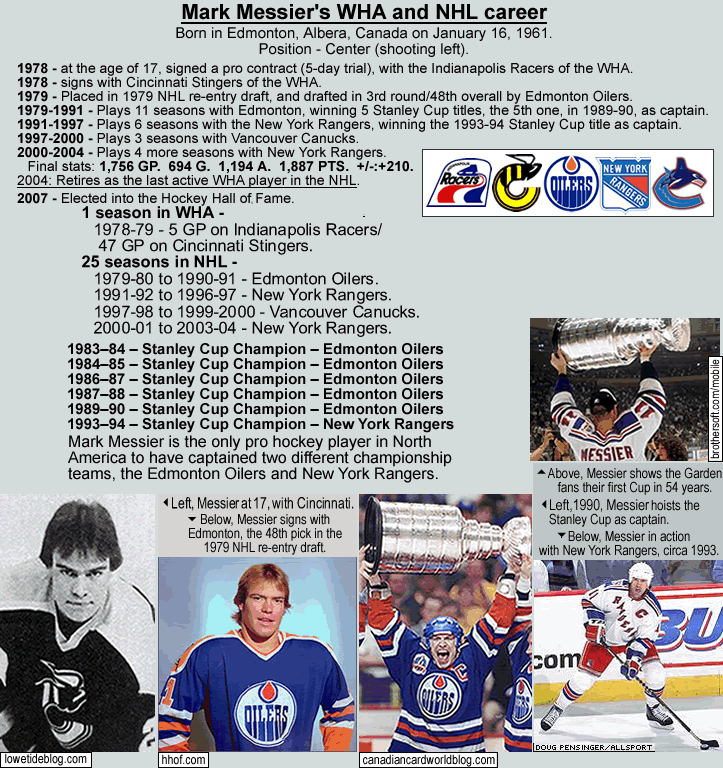
Photo credits -
lowetide.blogspot.com, hhof.com/Messier, canadacardworldblog.com, Doug Pensinger/Allsports via espn.go.com/readers/beloved/newyorkers, brothersoft.com/mobile/.
…
The WHA’s last season (1978-79)…
When the WHA’s Houston Aeros learned that the NHL did not have intentions of expanding south into the Sunbelt (not yet, anyway), the Aeros, one of the stronger WHA teams, cut their losses and folded after the 1977-78 season. That left a 7-team WHA to limp through their final season of 1978-79. Midway through that last WHA season, the Indianapolis Racers folded. The Indianapolis Racers are today best known for being the first pro team of Wayne Gretzky, who was 17 years old then. Gretzky only played 8 games for the Racers, then Racers’ owner Nelson Skalbania, who earlier that year, on the advice of Brmingham Bulls’ owner Tom Bassett, had signed Gretzky (to a 7-year personal-services contract worth $1.75 (US) million), sold Gretzky to the Edmonton Oilers. Gretzky, as a 17/18-year-old, then went on to finish third in scoring that season (behind Robbie Ftorek and Réal Cloutier), and helped lead the Oilers to the Avco Cup finals, which they lost to Winnipeg. It was the Winnipeg Jets’ 3rd Avco Cup title. [The Winnipeg Jets won the most titles in the 7-season WHA; the second-most was the 2 Avco Cup titles won by the Houston Aeros (last in 1975); and the other Avco Cup title winners were the Quebec Nordiques (in 1978) and the New England Whalers (in the first WHA season in 1973).] The $750,000 Skalbania got for Gretzky wasn’t enough to keep the Indianapolis team alive, though, and the Racers folded in December, 1978. The WHA finished their final season with just 6 teams – the Birmingham Bulls, the Cincinnati Stingers, the Edmonton Oilers, the New England Whalers, the Quebec Nordiques, and the Winnipeg Jets (I).
…
The NHL/WHA merger seems scuttled, until the power of the people (Canadian-style) prevails…
In March, 1979, another merger proposal – the one that eventually passed – was again voted down by one vote. The 5 NHL teams that voted against the merger on March 17, 1979 were the Montreal Canadiens, the Vancouver Canucks, the Boston Bruins, the Toronto Maple Leafs, and the Los Angeles Kings.
The reasons why those 5 NHL teams initially voted against the merger with the WHA…
Boston: did not want to share New England with the Whalers, plus the owner (Paul Mooney) never forgave the Whalers for signng so many ex-Bruins players circa 1972-75.
Montreal: see above, with respect to the fact that the Habs did not want to share the Francophone hockey fan base in Canada with the Quebec Nordiques. Plus, just as when, circa 1969-70, Montreal and Toronto tried to keep Vancouver out of the league because the 2 Canadian NHL teams then didn’t want to lose their lucrative slice of the pie from Hockey Night In Canada broadcasts, now those 3 Canadian NHL teams didn’t want to share that revenue 6 ways. In other words, the Montreal (and Toronto and Vancouver) top brass turned their backs on fellow Canadians by being Canadian citizens who did everything in their power to prevent Canadian hockey fans in 3 provincial cities the chance to be able to continue having local major-league-hockey teams.
Toronto: see Montreal, above, second and third sentences. Plus factor in how angry Leafs’ owner Harold Ballard was at the WHA for raiding the Leafs’ roster in the early days of the WHA (circa 1972-75), plus factor in what an unreasonable person the felon Ballard was.
Vancouver: see Montreal above, second and third sentences. In other words, the Canucks’ top brass were hypocrites, because in 1970 they almost didn’t get into the NHL for the same reason – now they were on the other side of the fence trying to keep other Canadian teams out. Plus they were afraid gates would suffer because they would not have as many home games versus Original 6 teams.
Los Angeles: See Vancouver, above, second sentence.
So what changed it? What got some of those teams to reverse their position and let there be major-league-NHL-hockey in Alberta, in the Canadian prairies, in the frozen north of Quebec, and in the state of Connecticut? A fan boycott. Over Molson Beer products, first organized in Edmonton, Quebec City, and Winnipeg, then spreading swiftly across all of Canada. Period.
From en.wikipedia.org/NHL-WHA merger,
{excerpt} …”The Canadiens were owned by Molson Brewery, and the Canucks served Molson products at their games. Fans in Edmonton, Winnipeg, and Quebec City, believing that Molson was standing in the way of their cities remaining big-league hockey towns, organized a boycott of Molson products. The boycott quickly spread nationwide. The Canadian House of Commons weighed in as well, unanimously passing a motion urging the NHL to reconsider. A second vote was held in Chicago on March 22, 1979, which passed by a 14–3 margin as both Montreal and Vancouver reversed their positions. Both teams’ hands were forced by the boycott, and the Canucks were also won over by the promise of a balanced schedule, with each team playing the others twice at home and twice on the road…”
{end of excerpt}.
…
The 1979 merger between the NHL and the WHA…
The NHL did not see Cincinnati or Birmingham as viable locations for franchises, and the Stingers and Bulls were paid to disband by getting $1.5 million apiece in parachute payments, then joining the Central Hockey League, the NHL-owned minor league, for one season each. The Stingers lasted just 33 games in the CHL in 1979-80; while the Birmingham Bulls played two full seasons in the CHL, folding after the 1980-81 season. Meanwhile, at the insistence of the Boston Bruins (again, one of the teams most hurt by the WHA), the New England Whalers were forced to change their name to the Hartford Whalers [the Whalers also got rid of their whale-harpoon-with-the-letter-W logo, and replaced it with a logo that had a white H and a green W under a blue whale fluke; plus the Whalers changed their colors to kelly green with blue trim (instead of dark green with yellow-orange trim) - see this, Hartford Whalers logos, from Chris Creamer's SportsLogos.net/Hartford Whalers].
So the 4 hockey franchises that moved over from the WHA to the NHL – as expansion teams – for the 1979-80 season were the Hartford Whalers, the Edmonton Oilers, the Quebec Nordiques, and the Winnipeg Jets (I).
The NHL really got the better of the WHA teams, to the point where it was officially called an expansion, not a merger. The WHA teams were stripped of almost all their players, and were only allowed to keep 2 goaltenders and two skating players. The four ex-WHA teams had to rebuild their rosters through the re-entry draft at $125,000 per player. [Note: that makes the fact that the Edmonton Oilers won their first Stanley Cup title in just their fifth season in the NHL (in 1984) all the more impressive.]
The 1979-80 NHL season…
Protective helmets were declared mandatory for all players, with players who signed contracts before June 1, 1979 having the option to not wear helmets (once they signed a waiver).
In December, 1979, the Detroit Red Wings moved over from the Detroit Olympia (capacity 15,000) to the Joe Louis Arena (capacity 19,875 [now it has a 20,066 capacity]).
The New York Islanders had a 25-point drop from the best-regular-season-points-tally of 116 in the previous season, to 86 points in 1979-90. But in the post-season, where it mattered, the Islanders 5th-seeding in the playoffs did not hold them back at all. On the other hand, the Philadelphia Flyers improved by 21 points over the previous season, and, propelled by a still-North-American-major-league-sports-record 35-game unbeaten run from mid-October to mid-January (25-0-10), the Flyers ended up with the best regular season record in 1979-80, with 116 points. The Buffalo Sabres finished as the second seed in the playoffs, with 110 points. Leading scorers were Marcel Dionne (of the Los Angeles Kings) and the 18/19 year-old Wayne Gretzky (of the Edmonton Oilers), both of whom had 137 points (with Dionne winning the Art Ross Trophy by virtue of having scored 2 more goals [53 goals] than Gretzky). Bob Edwards and Bob Suave of the Buffalo Sabres combined for the lowest goals-against-percentage and won the Vezina Trophy. None of the 4 new teams that had come over from the WHA had winning records, which came as no surprise, seeing as how the 4 “expansion teams” were stripped of all but 4 players each when they joined the NHL. Hartford and Edmonton did make the playoffs, though, as the 14th and 16th seeds, but both were swept in the 1st round of the playoffs.
1979-80 Stanley Cup Finals
The Philadelphia Flyers met the New York Islanders in the 1980 Stanley Cup Finals. It was the then-8-year-old-Islanders’ first Finals appearance. The Islanders were led by the “Trio Grande” line of C Bryan Trottier, LW Clark Gilles, and RW Mike Bossy (all Hall of Famers), and featured 2 other future Hall of Famers in D Denis Potvin and G Billy Smith. The Flyers had the second-best offense that season, with 327 goals (Montreal had 328 goals), and it was a real team effort as there were no Flyers players in the top 10 in scoring, although RW Reggie Leach had 50 goals (7th best); and Bobby Clarke and Ken Linseman both had 58 assists (tied for 8th best). Philadelphia also had the most players in the All-Star Game that season, with 7, including Leach, Rick MacLeish, and Bill Barber.
In Game 1, in Philadelphia, Denis Potvin won it for the Islanders with a power-play goal in overtime, for a 4-3 score. The Flyers answered with a flurry of goals in the second game, winning 8-3. The series resumed, at the Islanders’ home ice in Uniondale, New York, and saw the Islanders take control with a 6-2 win in Game 3; and then a 5-2 win in Game 4. Back at the Forum in Philly, the Flyers got back into it with a 6-3 win in Game 5. Back on Long Island for Game 6, Philadelphia looked poised to send the series back to Philadelphia and a seventh game, when they scored two late goals in the 3rd period – and the game went to overtime knotted at 4-4…
Via Youtube, here is Game 6 of the 1980 Stanley Cup Finals (Youtube video posted by Hockey Videos, a 3:46 video), which, at the 1:55 mark of the video, shows Isles’ C Lorne Henning, near the center-circle, threading the needle to fellow-third-line left-winger John Tonelli, whose goal-mouth-cross to RW Bob Nystrom is re-directed and floated over Flyers’ G Pete Peeters’ blocker pad, making the New York Islanders the champions. The Islanders would go on to establish themselves as one of the great dynasties of the NHL, winning four consecutive Stanley Cup titles…over Minnesota in 1981; over Vancouver in 1982; and over Edmonton in 1983. That 4-consecutive-Stanley-Cup-titles-run by the New York Islanders (1979-80 through to 1982-83) is surpassed only by the Montreal Canadiens, who won 5 straight Stanley Cup titles in the Original Six era, from 1955-56 through to 1959-60; and who also won 4 straight Stanley Cup titles from 1975-76 through to 1978-79.
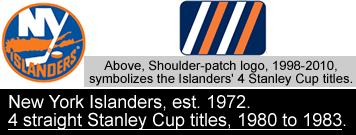
The Islanders’ victory over the Flyers in Game 6 of the 1980 Stanley Cup Finals was the last NHL game to air on network television in the United States for 9 years.
The following season, 1980-81, ex-WHA owner Nelson Skalbania purchased the foundering Atlanta Flames’ franchise and moved the team north, to Calgary, Alberta, Canada, as the Calgary Flames (NHL, 1980-present).

The season after that, 1981-82, the NHL went to geographically-oriented divisions and conferences.
The season after that, 1982-83, the Colorado Rockies were purchased by an East Coast-based consortium, and moved to northern New Jersey, as the New Jersey Devils (NHL, 1982-present).

The season after that, 1983-84, the Edmonton Oilers, with Wayne Gretzky as team captain and league-MVP, won the first of their 5 Stanley Cup titles.
{Old content disclaimer…the image-sequence below first appeared on this site here (The World Hockey Association, 1972-73 to 1978-79: map of all 26 teams, with attendance figures and notes.)}.
Below is a tribute to the WHA-era Edmonton Oilers, and to Glen Sather and Wayne Gretzky, the two people most responsible for bringing the Stanley Cup to Edmonton…
Photo and image credits –
Al Hamilton, HFboards.com/thread.
Old Oilers jersey illustration, http://whauniforms.com/.
Edmonton arenas: Edmonton Gardens (aka Livestock Pavillion), hockey.ballparks.com; Northlands Coliseum, http://hockey.ballparks.com/WHA/AlbertaOilers/index.htm
Gretzky on Indianapolis, 1978-79 indianapolis racers wayne gretzky jersey photos.
Wayne Gretzky on Sports illustrated cover, Wayne Gretzky Sports Illustrated covers gallery [12 SI covers between 1981 and 1999]..
_
Thanks to the JerseyDatabase.com site, for the jersey illustrations on the map page. As great as this site is, it is rather hard to navigate, so here is the page that will get you to NHL teams’ jerseys, http://www.jerseydatabase.com/browse.php?sport=nhl.
Thanks to NHL Uniforms.com, for bits of jerseys I needed to fill in (1979-80 Edmonton Oilers and 1979-80 Winnipeg Jets) because of gaps in the aforementioned database…www.nhluniforms.com/1979-80.
Thanks to Chris Creamer’s Sports Logos.net/NHL.
Thanks to WHA Hockey.com. Birmingham Bulls at WHA Hockey.com.
Thanks to WHA Hockey.tv. [Note, lots of Whalers' content here.]
Thanks to Ed Willes, for his book on the WHA…‘Rebel League, the short and unruly life of the World Hockey Association’, published by McLelland & Stewart, Toronto, 2004 {at Amazon, here}.


